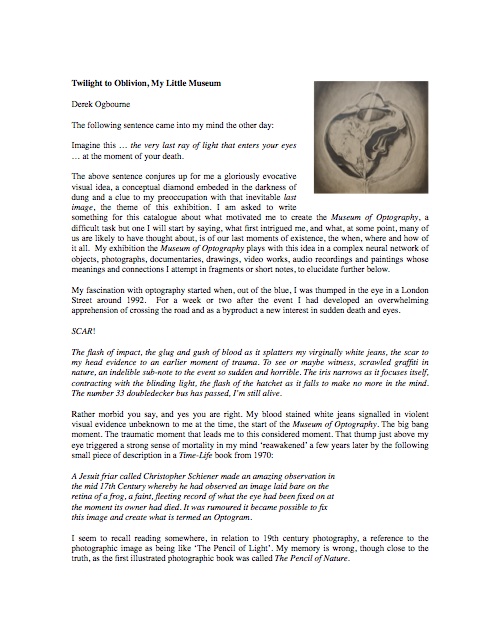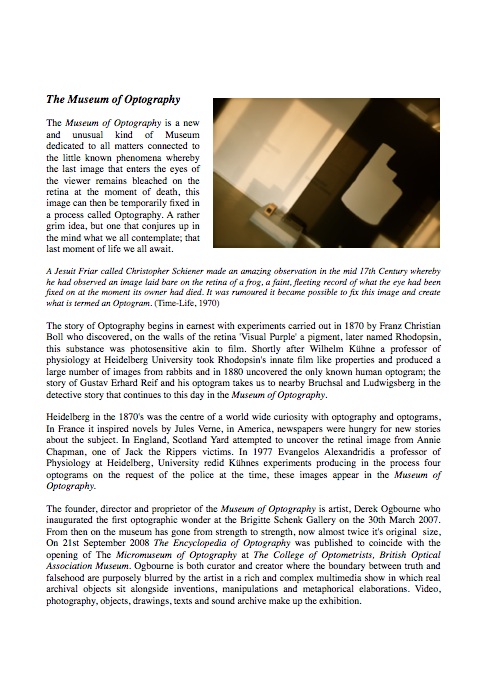'Cycling, Double Agents and Optography' and other texts

Cycling, Double Agents and Optography
The exhilaration of life, yes! Freewheeling on my bike down a hill after a long climb, I had begun to think about how grim the Museum of Optography was. I had forgotten how it is better to think of positive things in order to ease the pain of the hill. So I thought about the experience of sheer joy I felt when I spent time in my studio, all day making things with my hands, creating my Optographic monster. My distance from the horror is indeed one of the peculiarities of the
creative act.
My revelation started a few days ago while cycling. It was this act that affirmed life, it was as though the moment was about cramming as much thought in before the huge wall of bus ended it all for me. I began thinking about Kühne’s1 descriptions of the various experiments he had performed to understand Visual Purple and how there wasn’t one definitive way to obtain an optogram. It was similar to the process of taking and developing a photograph, though initially dependent on aperture, shutter speed, lens or film speed, many combinations making differing results. All this became clearer through my cycle journey home. I had forgotten how good for the perception intense exercise was, mindful that my thought was both highly sharp as to keep out of harm’s way and focused on how I was going to write this essay. Anyway, I realised I had gotten itwrong in my opening introduction to the Encyclopedia of Optography. I had written a definitive recipe on how to create an optogram, instead of explaining it was altogether a hit or miss affair.
It now sings out as a falsehood and lie. As I am writing this, I feel like a fraud or incompetent. But, this is a strong element of my Museum of Optography, an art project based on me building a lie, interlaced with truth. I am thinking out loud now.
As I cycled, I had to put the idea strands together and interweave them into abstract
notions. I was a double agent now or maybe a triple agent. Did the truth matter? Some art
historians in Heidelberg did an interview with me, with the title “Stört Sie, dass ich lüge?’’ translated with Google as "Do you mind that I'm lying?" Well, I never set out to lie, only recreate or interpret anew.
My cycle route was a well-trodden one for me, this allowed me to relax my bearings and concentrate on that long arduous hill to Swiss Cottage. It was a quiet hill near to the street where I suffered the whack to the head that covered my virgin jeans, in now, almost black blooded stains, the crime scene, thoughts of Jack the Ripper and another failed optogram experiment come to mind. The violent act, the sudden death, the exhilaration of the body, as we are acutely aware of ourselves as machines that are alive, yes, my videos to the newly initiated become clearer. With cycling, rhythm of thought is measured by the landmarks you pass by and how the body and machine traverses obstacles, straight runs allow the mind to wander away from the act, but the mind catnaps as at once it can be distracted by fear of being run over, the disorientating unforeseen punch to the head that started the great swindle of the Museum of Optography.
Derek Ogbourne 2011
1)Professor Wilhelm Kühne (March 28, 1837 - June 10, 1900) was a German physiologist who investigatedvision and the chemical processes involved in how the retina functions.
Tuesday, 13 February 2024

Twilight to Oblivion, My Little Museum
Click above for pdf
My catalogue text for my show at The
Kurpfälzisches Museum im Palais Morass, Heidelberg, Germany. July 6th - September 6th 2010. Other texts by Stefanie Boo, Kristina Hoge Dr. Frieder Hepp, and an interview with Dr . Evangelos Alexandridis
The Museum of Optography
Click above for pdf
My introductory text for my Encyclopedia of Optography 2009
These are texts written by me...
Derek Ogbourne

